Effects of River Migration and Water-Sediment Regulation Scheme on Total Nitrogen Transport in the Yellow River Estuary
Abstract
1. Introduction
2. Materials and Methods
2.1. Study Area
2.2. Data
2.3. Numerical Model
2.3.1. Model Description
2.3.2. Key Parameters of the Model
3. Model Verification
3.1. Verification of Hydrodynamic
3.2. Verification of TN
4. Results and Discussion
4.1. The Effect of River Channel Change on TN Transport in the YRE
4.2. The Effect of the WSRS on Nutrient Transport in the YRE
5. Conclusions
- (1)
- The change in river channel direction in the YRD affected the diffusion direction of high-concentration-TN water in the YRE, from the east–west diffusion in 2009 to the north–south diffusion in 2019.
- (2)
- For the years with the WSRS (2009 and 2019), the farthest diffusion distance of the high-concentration-TN water body is basically consistent with the edge of the estuary plume. In 2009, it was about 30 km to the southeast side of the estuary, and in 2019, it was about 26.5 km to the north side of the estuary. At 25–26 °C, TN concentrations of 0.5 mg/L (2009) and 1.05 mg/L (2019) can be used as the threshold for the longest diffusion distance to different river channels.
- (3)
- For the year without the WSRS (2017), TN concentration in the YRE was generally lower than 2 mg/L from June to July, and below the average concentration during 2019. In addition, the average northward diffusion distance in 2017 was only 10% of the average during the 2019 WSRS.
- (4)
- Runoff directly determines the diffusion range of TN in the YRE. The average runoff during the WSRS in 2019 was 6.88 times that during the same period in 2017, resulting in a 10-times-higher diffusion distance for high TN concentrations in 2019 compared with 2017.
Author Contributions
Funding
Institutional Review Board Statement
Informed Consent Statement
Data Availability Statement
Acknowledgments
Conflicts of Interest
References
- Huang, X.; Zhang, D.; Wang, F.; Zhao, Z.; Chen, A.; Zhang, J.; Zhang, C.; Wu, L.; Li, Y.; Ma, B.; et al. Porewater dissolved inorganic carbon released due to artificial scouring in the Yellow River. Appl. Geochem. 2023, 149, 105557. [Google Scholar] [CrossRef]
- Dai, M.; Wang, L.; Guo, X.; Zhai, W.; Li, Q.; He, B.; Kao, S.J. Nitrification and inorganic nitrogen distribution in a large perturbed river/estuarine system: The Pearl River Estuary, China. Biogeosciences 2008, 5, 1545–1585. [Google Scholar] [CrossRef]
- Bi, N.; Yang, Z.; Wang, H.; Hu, B.; Ji, Y. Sediment dispersion patterns off the present Huanghe (Yellow River) subdelta and its dynamic mechanism during normal river discharge period. Estuar. Coast. Shelf Sci. 2010, 86, 352–362. [Google Scholar]
- Domingues, R.B.; Barbosa, A.B.; Sommer, U.; Galvaoa, H.M. Phytoplankton composition, growth and production in the Guadiana estuary (SW Iberia): Unraveling changes induced after dam construction. Sci. Total Environ. 2012, 416, 300–313. [Google Scholar] [CrossRef] [PubMed]
- Dong, Z.J.; Yang, Q.; Sun, T.T.; Wang, Y.J.; Jiang, H.C.; Liu, D. Spatial and seasonal variability of the zooplankton community in the Yellow River Estuary’s adjacent sea. Acta Ecol. Sin. 2017, 37, 659–0667. [Google Scholar]
- Zhang, J.F.; Zhang, M.M.; Zhang, S.X.; Xu, Q.; Liu, X.X.; Zhang, Z.Y. Nutrient distribution and structure affect the behavior and speciation of arsenic in coastal waters: A case study in southwestern coast of the Laizhou Bay, China. Mar. Pollut. Bull. 2019, 146, 377–386. [Google Scholar] [CrossRef]
- Chi, Y.; Zhao, M.W.; Sun, J.K.; Xie, Z.L.; Wang, E.K. Mapping soil total nitrogen in an estuarine area with high landscape fragmentation using a multiple-scale approach. Geoderma 2019, 339, 70–84. [Google Scholar] [CrossRef]
- Zhang, T.; Song, B.; Han, G.X.; Zhao, H.L.; Hu, Q.L.; Zhao, Y.; Liu, H.J. Effect of coastal wetland reclamation on soil organic carbon, total nitrogen, and total phosphorus in China; A meta-analysis. Land Degrad. Dev. 2023, 34, 3340–3349. [Google Scholar] [CrossRef]
- Ji, H.Y.; Pan, S.Q.; Chen, S.L. Impact of river discharge on hydrodynamics and sedimentary processes at yellow river delta. Mar. Geol. 2020, 425, 106210. [Google Scholar] [CrossRef]
- Liu, S.M.; Li, L.W.; Zhang, G.L.; Liu, Z.; Yu, Z.G.; Ren, J.L. Impact of human activities on nutrient transport in the Huanghe (Yellow River) estuary. J. Hydrol. 2012, 430–431, 103–110. [Google Scholar] [CrossRef]
- Milliman, J.D.; Meade, R.H. World-wide delivery of river sediment to the oceans. J. Geol. 1983, 91, 1–21. [Google Scholar] [CrossRef]
- Bai, J.; Xiao, R.; Zhang, K.; Gao, H. Arsenic and heavy element pollution in wetland soils from tidal freshwater and salt marshes before and after the flow-sediment regulation regime in the Yellow River Delta, China. J. Hydrol. 2012, 450–451, 244–253. [Google Scholar] [CrossRef]
- Bi, N.S.; Yang, Z.S.; Wang, H.J.; Xu, C.L.; Guo, Z.G. Impact of artificial water and sediment discharge regulation in the Huanghe (Yellow River) on the transport of particulate heavy metals to the sea. Catena 2014, 121, 232–240. [Google Scholar] [CrossRef]
- Cheng, Q.L.; Zhou, W.F.; Zhang, J.; Shi, L.; Xie, Y.F.; Li, X.D. Spatial variations of arsenic and heavy metal pollutants before and after the water-sediment regulation in the wetland sediments of the Yellow River estuary, China. Mar. Pollut. Bull. 2019, 145, 138–147. [Google Scholar] [CrossRef]
- Hou, C.Y.; Yi, Y.J.; Song, J.; Zhou, Y. Effect of water-sediment regulation operation on sediment grain size and nutrient content in the lower Yellow River. J. Clean. Prod. 2021, 279, 123533. [Google Scholar] [CrossRef]
- Qiao, S.W.; Yang, Y.Y.; Xu, B.C.; Yang, Y.; Zhu, M.M.; Li, F.; Yu, H.M. How the Water-Sediment Regulation Scheme in the Yellow River affected the estuary ecosystem in the last 10 years? Sci. Total Environ. 2024, 927, 172002. [Google Scholar] [CrossRef]
- Hu, X.L.; Chen, S.L.; Liu, X.X.; Gu, G.C. Diffusion path and range of water flow and sediment in Yellow River Estuary during water-sediment regulation in 2012. J. Sediment Res. 2014, 3, 49–56. (In Chinese) [Google Scholar]
- Zhang, X.D.; Yang, Z.S.; Zhang, Y.X.; Ji, Y.; Wang, H.M.; Lv, K.; Lu, Z.Y. Spatial and temporal shoreline changes of the southern Yellow River (Huanghe) Delta in 1976–2016. Mar. Geol. 2018, 395, 188–197. [Google Scholar] [CrossRef]
- Xu, Y.; Pu, L.; Liao, Q.; Zhu, M.; Yu, X.; Mao, T.; Xu, C. Spatial Variation of Soil Organic Carbon and Total Nitrogen in the Coastal Area of Mid-Eastern China. Int. J. Environ. Res. Public Health 2017, 14, 780. [Google Scholar] [CrossRef]
- Li, X.Y.; Chen, H.T.; Jiang, X.Y.; Yu, Z.G.; Yao, Q.Z. Impacts of human activities on nutrient transport in the Yellow River: The role of the water-sediment regulation scheme. Sci. Total Environ. 2017, 592, 161–170. [Google Scholar] [CrossRef]
- Peng, J.; Chen, S.; Dong, P. Temporal variation of sediment load in the Yellow River basin, China, and its impacts on the lower reaches and the river delta. Catena 2010, 83, 135–147. [Google Scholar] [CrossRef]
- Bi, H.S.; Sun, S.; Gao, S.W. Ecological characteristics of zooplankton community in Bohai Sea I: Species composition and community structure. Acta Ecol. Sin. 2000, 20, 715–721. [Google Scholar]
- Meybeck, M. The global change of continental aquatic systems: Dominant impacts of human activities. Water Sci. Technol. 2004, 49, 73–83. [Google Scholar] [CrossRef] [PubMed]
- Huai, W.X.; Zeng, X.H.; Komatsu, T. Numerical simulation of residual circulation due to bottom roughness variability under tidal flows in a semi-enclosed bay. China Ocean. Eng. 2005, 19, 601–612. [Google Scholar]
- Kuang, C.P.; Chen, S.Y.; Zhang, Y.; Gu, J.; Pan, Y.; Huang, J. A two-dimensional morphological model based on a next generation circulation solver I: Formulation and validation. Coast. Eng. 2012, 59, 1–13. [Google Scholar] [CrossRef]
- Xue, S.L.; Jian, H.M.; Yang, F.X.; Liu, Q.; Yao, Q.Z. Impact of water-sediment regulation on the concentration and transport of dissolved heavy metals in the middle and lower reaches of the Yellow River. Sci. Total Environ. 2022, 806, 150535. [Google Scholar]
- Wang, H.J.; Wu, X.; Bi, N.S.; Li, S.; Yuan, P.; Wang, A.M.; Syvitski, J.P.M.; Saito, Y.; Yang, Z.S.; Liu, S.M.; et al. Impacts of the dam-orientated water-sediment regulation scheme on the lower reaches and delta of the Yellow River (Huanghe): A review. Glob. Planet. Change 2017, 157, 93–113. [Google Scholar] [CrossRef]
- Xia, X.H.; Dong, J.W.; Wang, M.H.; Xie, H.; Xia, N.; Li, H.S.; Zhang, X.T.; Mou, X.L.; Wen, J.J.; Bao, T.M. Effect of water-sediment regulation of the Xiaolangdi reservoir on the concentrations, characteristics, and fluxes of suspended sediment and organic carbon in the Yellow River. Sci. Total Environ. 2016, 571, 487–497. [Google Scholar] [CrossRef]
- Yu, Y.; Shi, X.F.; Wang, H.J.; Yue, C.K.; Chen, S.L.; Liu, Y.G.; Hu, L.M.; Qiao, S.Q. Effects of dams on water and sediment delivery to the sea by the Huanghe (Yellow River): The special role of water-sediment modulation. Anthropocene 2013, 3, 72–82. [Google Scholar] [CrossRef]
- Zhang, X.L.; Chen, H.T.; Yao, Q.Z.; Zhang, X.X. The seasonal changes and flux of trace elements in the lower reaches of Yellow River. Period. Ocean. Univ. China 2013, 43, 69–75. [Google Scholar]
- Zhou, Q.Q.; Yang, N.; Li, Y.Z.; Ren, B.; Ding, X.H.; Bian, H.L.; Yao, X. Total concentrations and sources of heavy metal pollution in Global River and Lake water bodies from 1972 to 2017. Glob. Ecol. Conserv. 2020, 22, e00925. [Google Scholar] [CrossRef]
- Seitzinger, S.P.; Mayorga, E.; Bouwman, A.F.; Kroeze, C.; Beusen, A.H.W.; Billen, G.; Van Drecht, G.; Dumont, E.; Fekete, B.M.; Garnier, J. Global river nutrient export: A scenario analysis of past and future trends. Glob. Biogeochem. Cycles 2010, 24, 2621–2628. [Google Scholar] [CrossRef]
- Wang, Z.L.; Geng, Y.F.; Jin, S. An unstructured finite-volume algorithm for nonlinear two-dimensional shallow water equation. J. Hydrodyn 2005, 17, 306–312. [Google Scholar]
- Geng, Y.F.; Wang, Z.L. A coastal ocean model of semi-implicit finite volume unstructured grid. China Ocean. Eng. 2012, 26, 277–290. [Google Scholar] [CrossRef]
- Hou, Q.Z.; Lu, Y.J.; Wang, Z.L.; Mo, S.P. Cumulative response of estuarine bay hydrodynamic environment to human activities: Example of Lingding Bay of the Pearl River Estuary. Water Sci. 2019, 30, 789–799. [Google Scholar]
- Wang, Z.L.; Lu, Y.J.; Zuo, L.Q. Unstructured 3D baroclinic model of current and salt for strong tidal estuary. Ocean. Eng. 2008, 26, 44–53. [Google Scholar]
- Xue, B.S.; Lu, Y.J.; Xiao, H.Q.; Wang, Z.L.; Wu, P.; Diao, M.J. Processes of stratification and vertical turbulent mixing in a choked lagoon system. Estuarine Coast. Shelf Sci. 2024, 299, 108663. [Google Scholar] [CrossRef]
- Zolfaghari, H.; Becsek, B.; Nestola, M.G.C.; Sawyer, W.B.; Krause, R.; Obrist, D. High-order accurate simulation of incompressible turbulent flows on many parallel GPUs of a hybrid-node supercomputer. Comput. Phys. Commun. 2019, 244, 132–142. [Google Scholar] [CrossRef]
- Bonaglia, S.; Deutsch, B.; Bartoli, M.; Marchant, H.M.; Bruchert, V. Seasonal oxygen, nitrogen and phosphorus benthic cycling along an impacted Baltic Sea estuary: Regulation and spatial patterns. Biogeochemistry 2014, 119, 139–160. [Google Scholar] [CrossRef]
- Li, G.Y.; Sheng, L.X. Model of water-sediment regulation in Yellow River and its effect. Sci. China Technol. Sci. 2011, 54, 924–930. [Google Scholar] [CrossRef]
- Wahl, D.H.; Goodrich, J.; Nannini, M.A.; Dettmers, J.M.; Soluk, D.A. Exploring riverine zooplankton in three habitats of the Illinois River ecosystem: Where do they come from? Limnol. Oceanogr. 2008, 53, 2583–2593. [Google Scholar] [CrossRef]
- Zhang, S.; Pei, H.; Wei, J.; Zhu, Y.; Wang, Y.; Yang, Z. The seasonal and spatial variations in diatom communities and the influence of environmental factors on three temperate reservoirs in Shandong province, China. Environ. Sci. Pollut. Res. 2019, 26, 24503–24515. [Google Scholar] [CrossRef]
- Xu, B.; Yang, D.; Burnett, W.C.; Ran, X.; Yu, Z.; Gao, M.; Diao, S.; Jiang, X. Artificial water sediment regulation scheme influences morphology, hydrodynamics and nutrient behavior in the Yellow River estuary. J. Hydrol. 2016, 539, 102–112. [Google Scholar] [CrossRef]
- Ying, Y.M.; Wang, X.; Shang, M.; Cun, X.R.; Huang, R.J.; Su, C.L.; Han, B.; Huang, Q. Effects of Water-Sediment Regulation on spatial-temporal distribution of nutrients in the lower Yellow River. Res. Square 2024, preprint. [Google Scholar] [CrossRef]
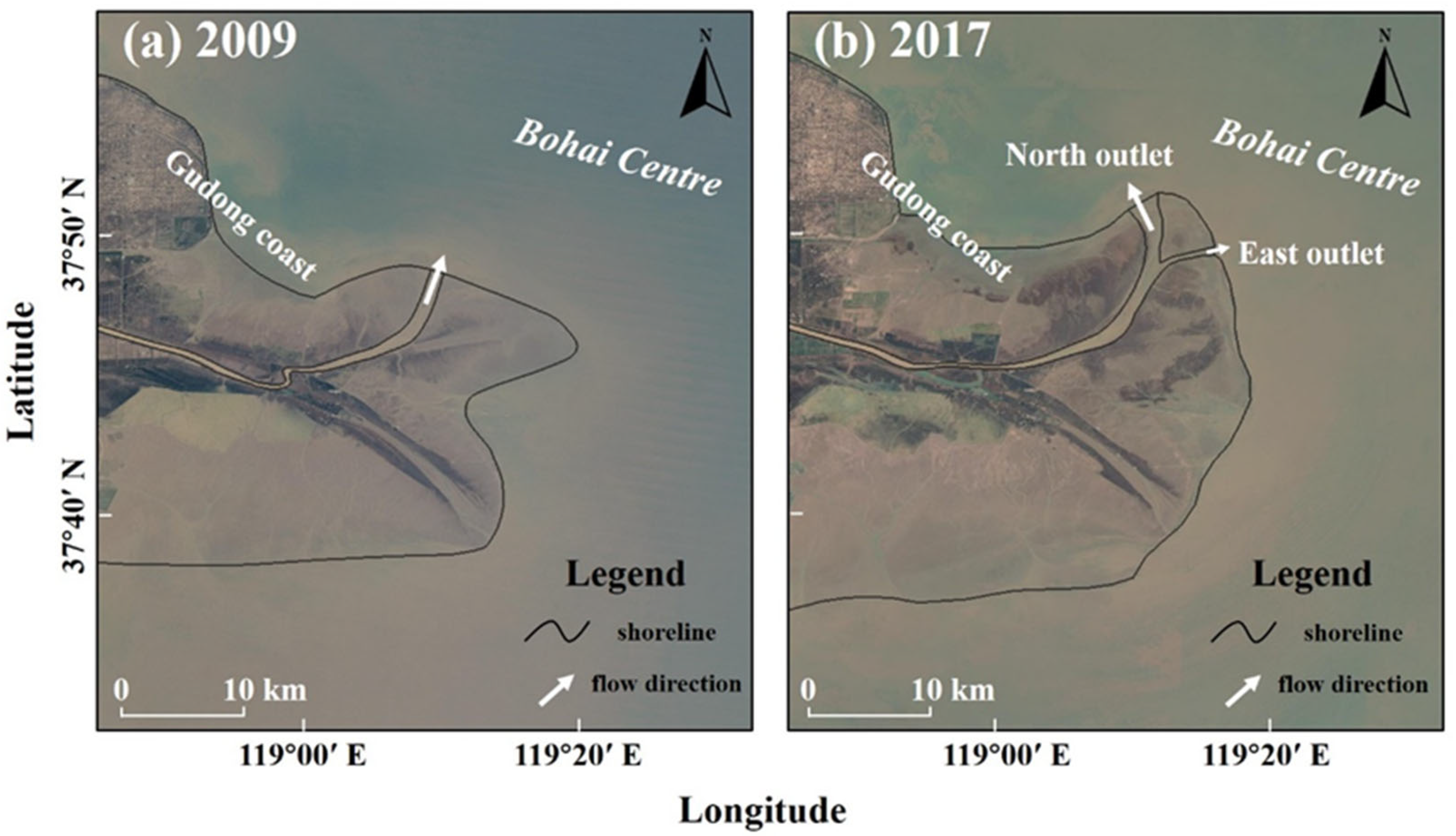

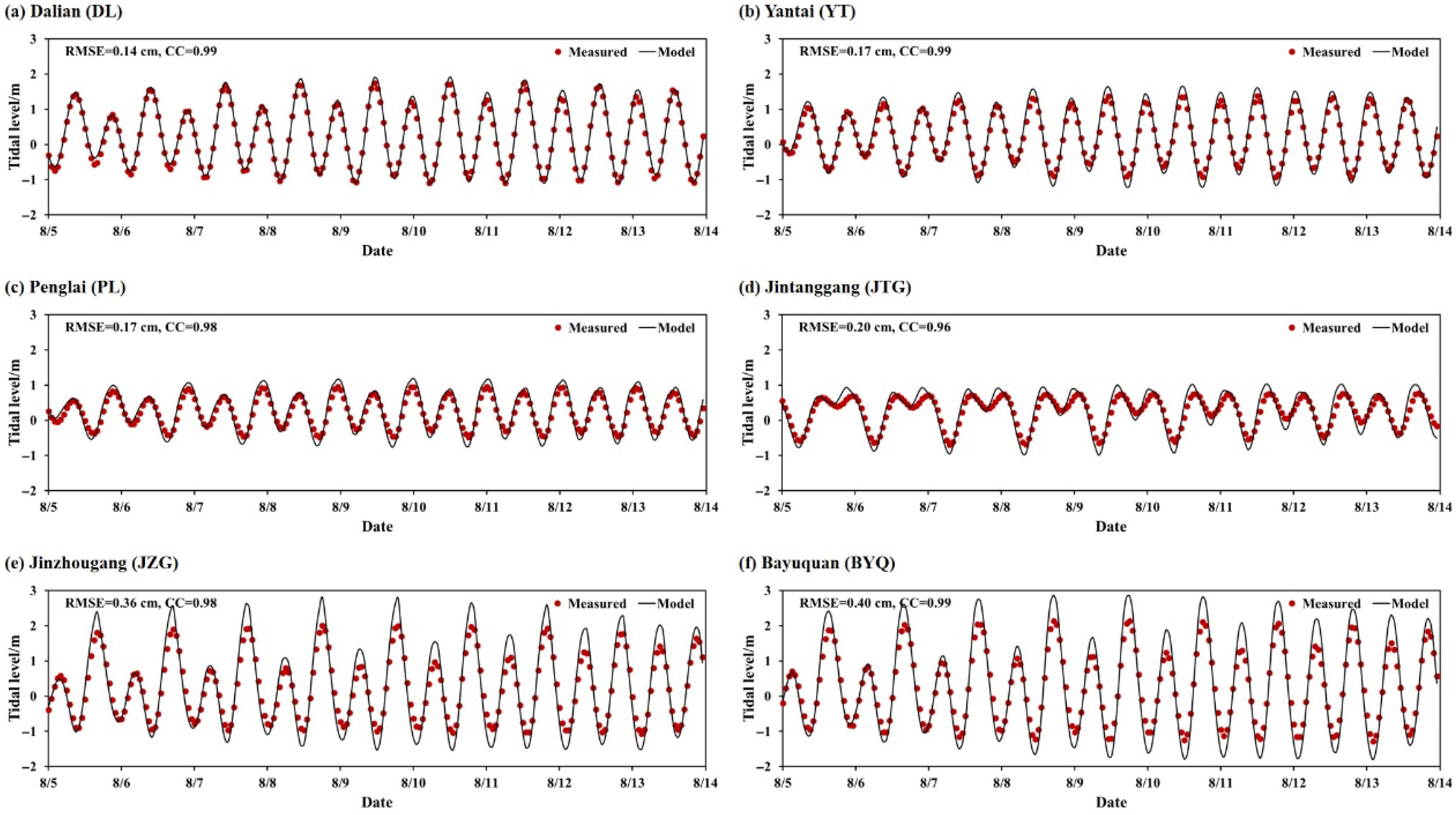
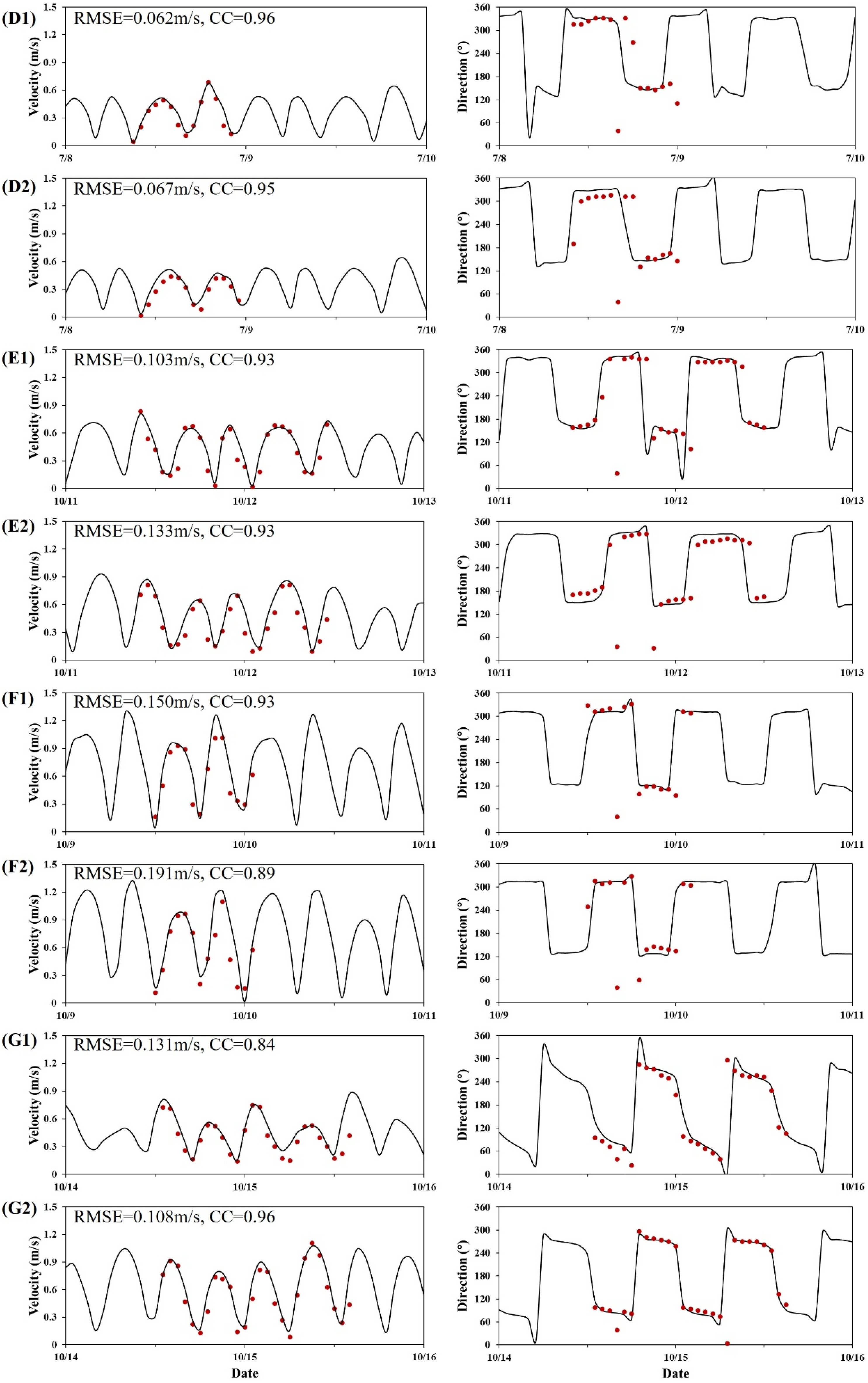
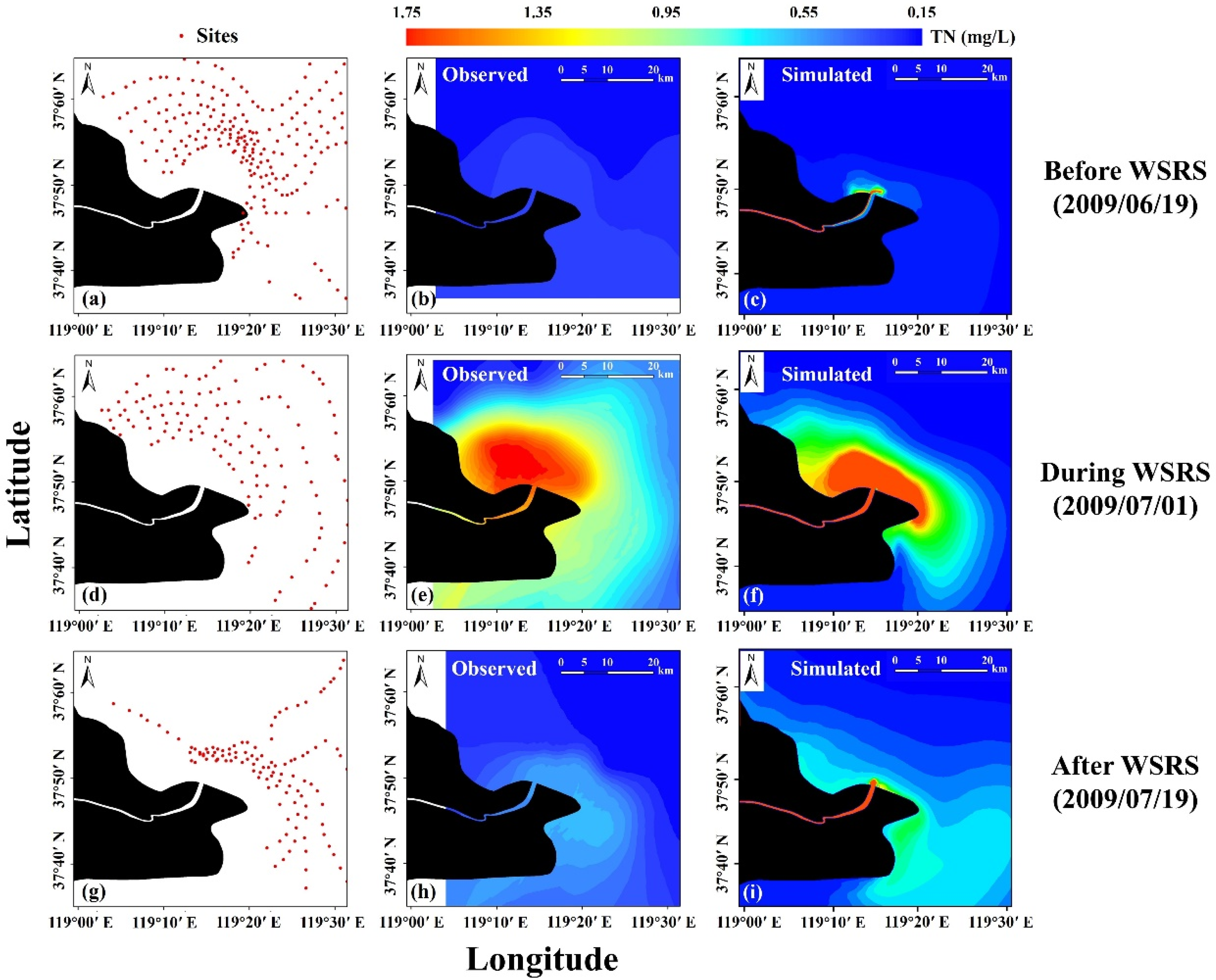

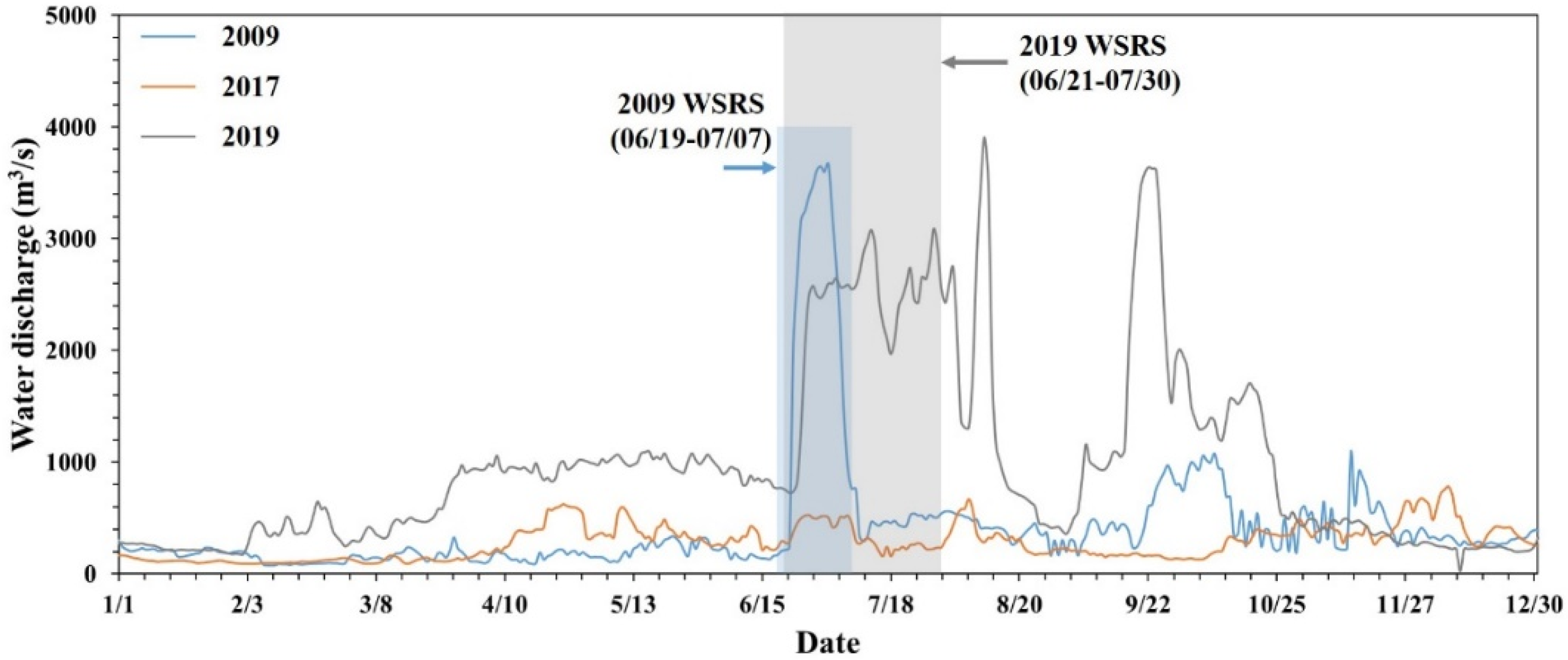
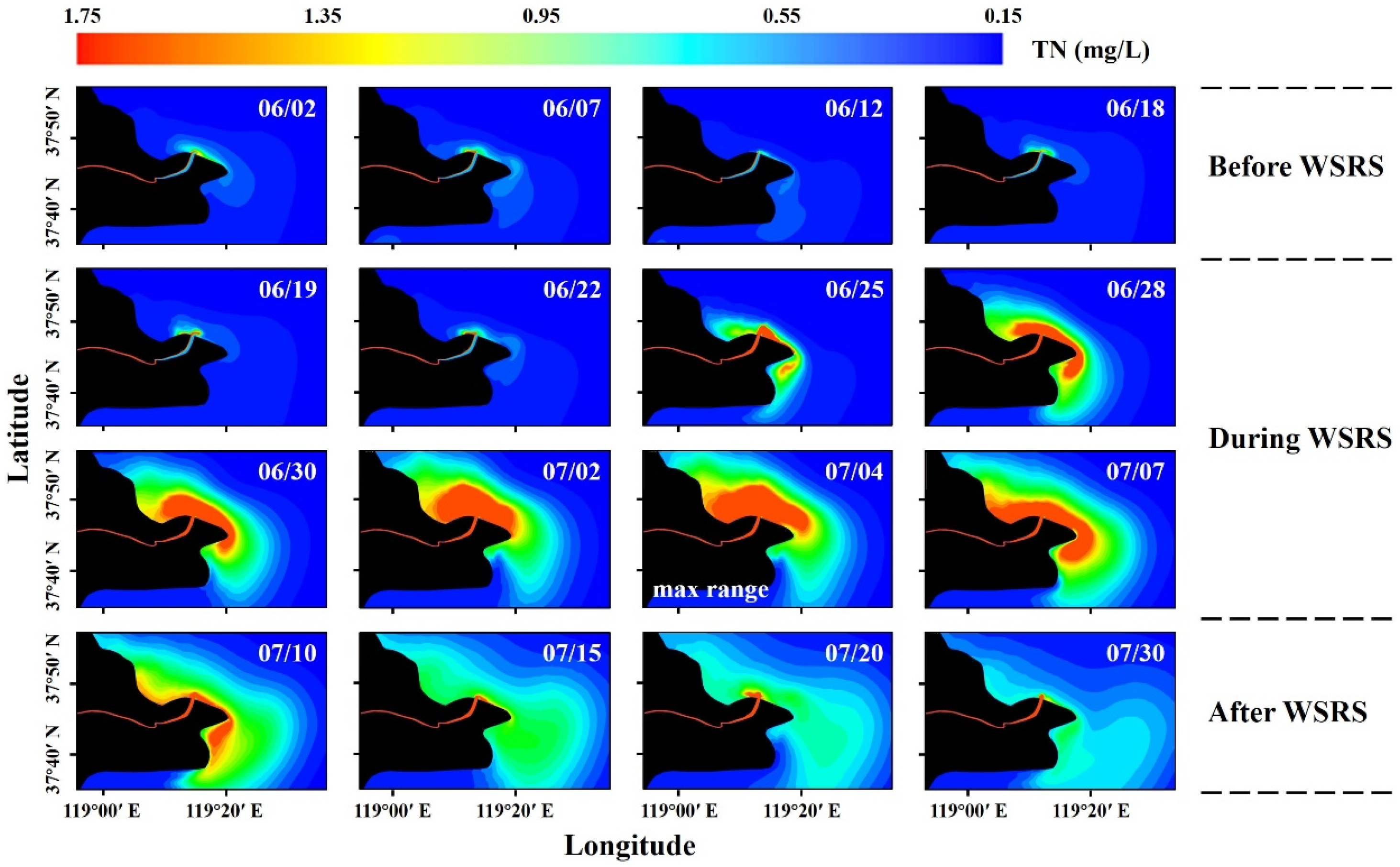
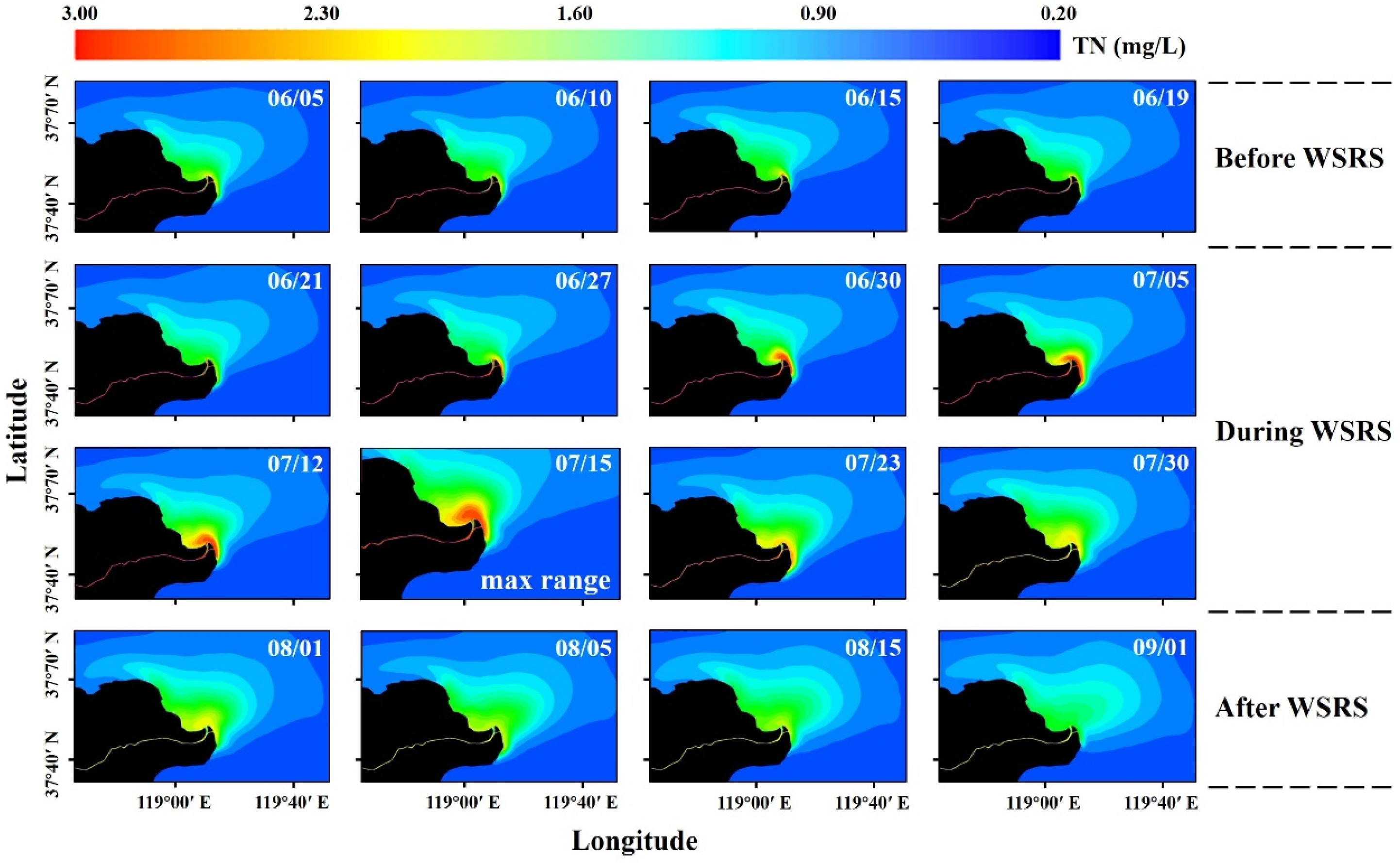
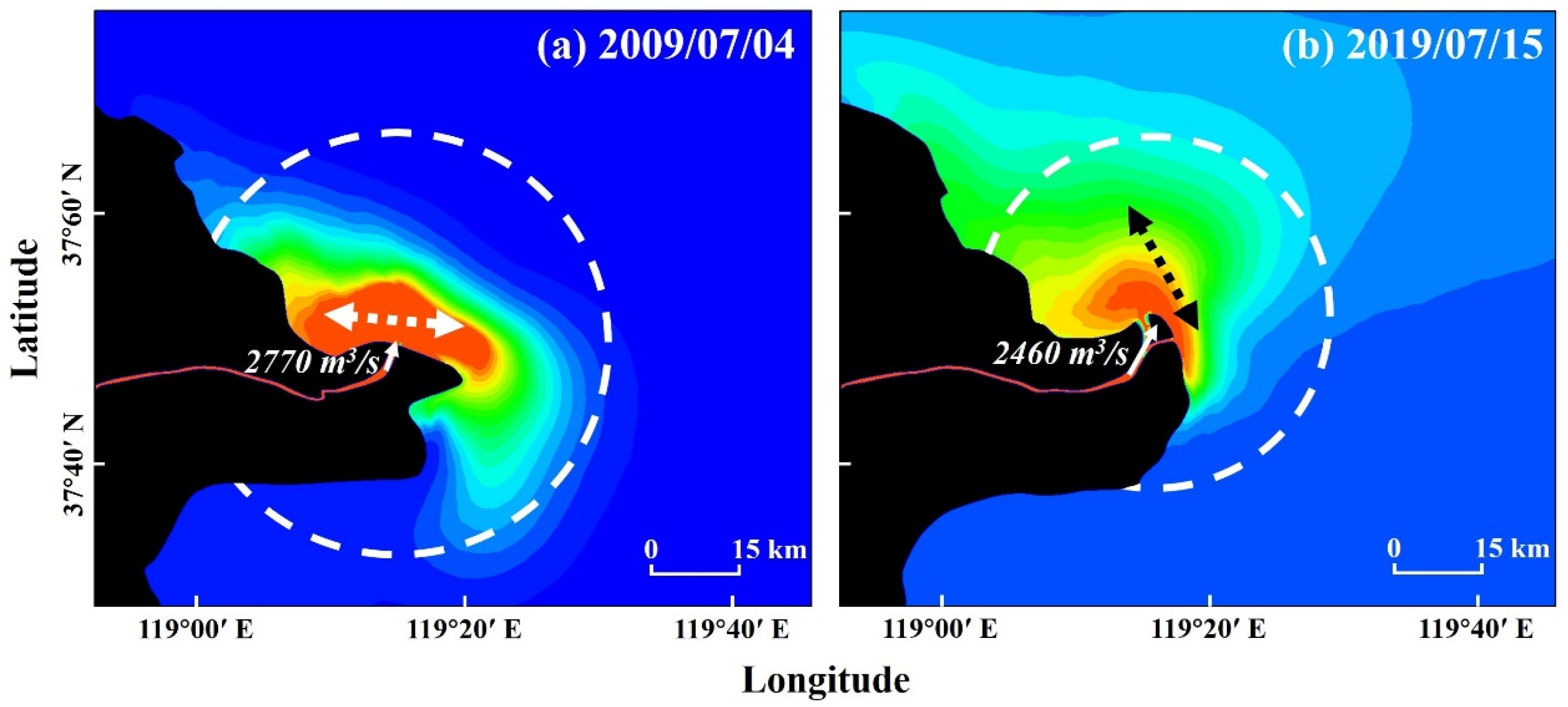
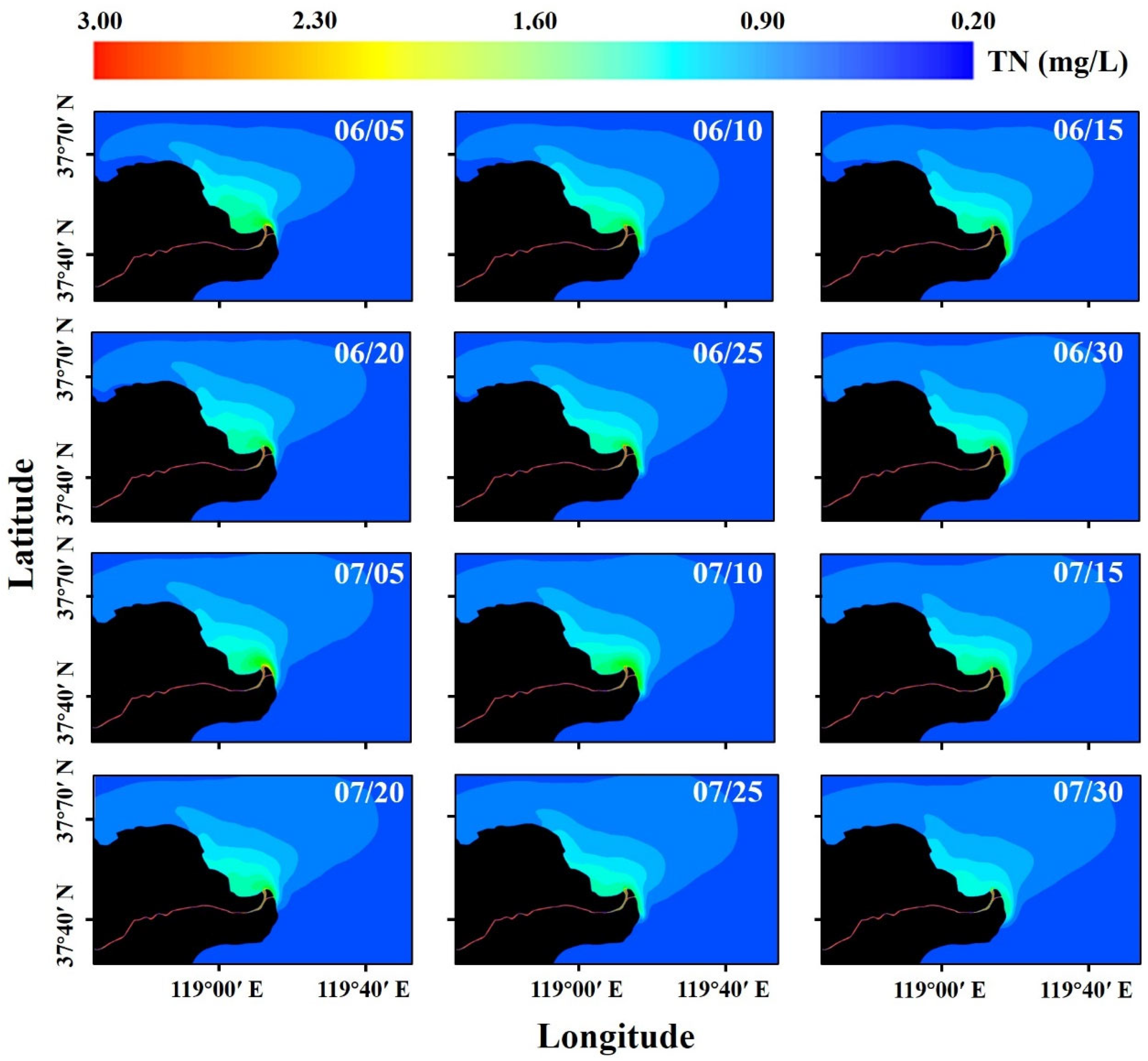
Disclaimer/Publisher’s Note: The statements, opinions and data contained in all publications are solely those of the individual author(s) and contributor(s) and not of MDPI and/or the editor(s). MDPI and/or the editor(s) disclaim responsibility for any injury to people or property resulting from any ideas, methods, instructions or products referred to in the content. |
© 2025 by the authors. Licensee MDPI, Basel, Switzerland. This article is an open access article distributed under the terms and conditions of the Creative Commons Attribution (CC BY) license (https://creativecommons.org/licenses/by/4.0/).
Share and Cite
Li, C.; Wang, Z.; Lu, Y.; Zhu, L.; Dong, B.; Wei, X. Effects of River Migration and Water-Sediment Regulation Scheme on Total Nitrogen Transport in the Yellow River Estuary. Sustainability 2025, 17, 9145. https://doi.org/10.3390/su17209145
Li C, Wang Z, Lu Y, Zhu L, Dong B, Wei X. Effects of River Migration and Water-Sediment Regulation Scheme on Total Nitrogen Transport in the Yellow River Estuary. Sustainability. 2025; 17(20):9145. https://doi.org/10.3390/su17209145
Chicago/Turabian StyleLi, Chang, Zhili Wang, Yongjun Lu, Lingling Zhu, Bingjiang Dong, and Xianglong Wei. 2025. "Effects of River Migration and Water-Sediment Regulation Scheme on Total Nitrogen Transport in the Yellow River Estuary" Sustainability 17, no. 20: 9145. https://doi.org/10.3390/su17209145
APA StyleLi, C., Wang, Z., Lu, Y., Zhu, L., Dong, B., & Wei, X. (2025). Effects of River Migration and Water-Sediment Regulation Scheme on Total Nitrogen Transport in the Yellow River Estuary. Sustainability, 17(20), 9145. https://doi.org/10.3390/su17209145






